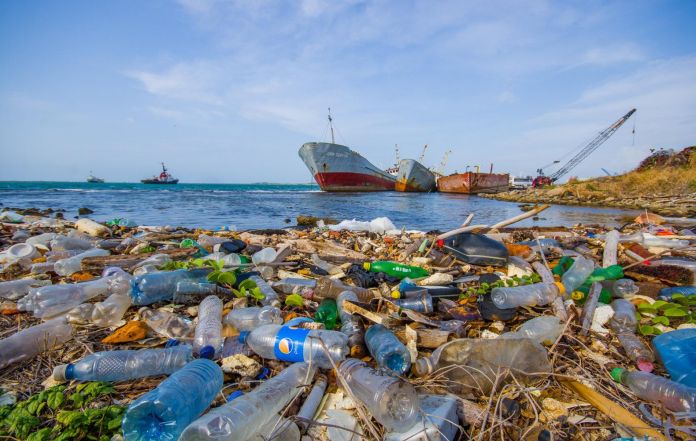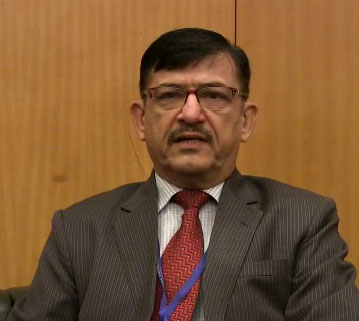The ‘Shared Vision of India-Indonesia Maritime Cooperation in the Indo-Pacific’1 announced by Prime Minister Narendra Modi and President Joko Widodo of Indonesia lists several issues for practical cooperation. Broadly, the leaders identified and endorsed six thematic areas including sustainable development of marine resources clearly acknowledging the critical necessity to ensure good health for the oceans and seas. The vision document urges the policy makers and implementing agencies to ensure concerted efforts on a number of interrelated issues of climate change: marine environment; sustainable development of marine resources; blue economy; illegal, unregulated, and unreported (IUU) fishing; and combating marine plastic debris through bilateral and regional cooperation.
It was only in the fitness of things that the two leaders specially chose to include plastic litter in their Shared Vision given that the issue is high on the agenda of several multilateral institutions, regional organizations and most states have taken major initiatives to address the problem. It also gains greater salience due to the fact that India and Indonesia are close maritime neighbours and separated by only 90 nautical miles in the Bay of Bengal, i.e. between Andaman and Nicobar Islands of India and Banda Aceh province in Sumatera Island of Indonesia. Given that environmental and ecological degradation is not bound by cartographic delimitations, and has an effect in the neighborhood too, India and Indonesia are confronted with the issue of marine litter.
Plastic Litter in Bay of Bengal
Like any large water body, the Bay of Bengal has its share of plastic litter and patches of debris have been discovered at sea as also along the coastlines of the littoral states. Ironically, the Bay of Bengal and the South China Sea are the new plastic hotspots in Asia, and the former is more polluted than the Indian Ocean gyre.2 The Helmholtz Centre for Polar and Marine Research of the Alfred Wegener Institute has compiled scientific data and published a map on marine litter which includes the Bay of Bengal. 3
Further, among the 10 rivers across the globe that are responsible for dumping almost four million tons of plastic into the seas every year4, the Ganges in India which drain into the Bay of Bengal along with Irrawaddy in Myanmar, have been identified as majorly responsible for polluting Bay of Bengal with marine debris; in Indonesia, Brantas and Solo are described as highly polluting. Apparently, Indonesia is the second-largest contributor to marine plastic pollution after China, and is estimated to emit around 200,000 tonnes of plastic from rivers and streams, mainly from Java and Sumatra.5 The fishermen from the Lhokseumawe area in the Aceh Province complained early this year about plastic and household waste found afloat and caught in the nets along with fish.6
An Indian National Institute of Ocean Technology (NIOT) study on Coastal Ocean Monitoring and Prediction System, undertaken as early as 2003, concluded that marine debris along the Great Nicobar and Nancowry Islands in the Nicobar Group was unusually high when compared with the population of the islands (1800 islanders and 1000 tribal based on 1992 census). 7 Further, the debris was not of local origin and it was observed that it may have originated in the neighboring countries (Singapore, Malaysia, Indonesia, Sumatra, and other Southeast Asian countries), and had drifted towards the Nicobar Group of islands due to currents and wind.
Impact on Marine Ecosystem
Marine litter adversely impacts the marine and aquatic life and the associated eco-system. There is now mounting evidence of the presence of plastic in sea creatures including those that habit the seabed, sea birds, and mammals. 8 Over 50 per cent of sea turtles may have consumed plastic and many pictures showcase the sordid story of these harmless creature found wrapped in plastic bags or entangled in fishing nets have shocked the international community. Likewise, large sea creatures such as whales too have been victim of plastic debris. There have been several instances of whales washing ashore along the Indian coast particularly in the Bay of Bengal. In 1973, 147 whales were found on the beach off the Tuticorin coast, and in 2016, 80 short-finned pilot whales were found stranded on the sand in the same area.9 Again in August 2017, a 3.5 tons 18-foot whale shark washed up on Pamban beach in Tamil Nadu.10
It is plausible that many of the recent stranding are due to ingestion of marine litter, that can potentially cause physical damage to their digestive systems and may eventually give the animals the sensation of being full and reduce their instinct to feed, leading to malnutrition.11 For instance, in 2016 the necropsy of a sperm whale that beached and got stranded on Germany’s North Sea coast had fishing gear and an engine cover inside its stomach.
Besides plastic debris, marine life is also affected by the underwater noise generated by merchant shipping, fishing trawlers, and offshore exploration including laying of oil and gas pipelines and fiber optic cables. Also, powerful Sonar transmissions from the warships can potentially lead to internal bleeding in mammals causing damage to ear and brain tissues, resulting in disorientation or death of mammals. There is also a belief that whales may even misunderstand Sonar waves as an attacker, and cause panic driving them towards shores.
Challenges and Options
There are at least four major challenges for addressing marine litter problem in the Bay of Bengal particularly in waters contiguous to India and Indonesia. First, as noted earlier, rivers that drain in the Bay of Bengal are of primary concern given that these carry and discharge plastic debris, liquid and solid industrial discard and untreated domestic and human waste. Besides, persistent organic pollutants, radioactive substances, heavy metals, hydrocarbons and plastic litter have also been detected in the Bay of Bengal. 12 It will be useful to explore if the issue can be debated among the Bay of Bengal littorals at both the East Asia Summit and the Bay of Bengal Initiative for Multi-Sectoral Technical and Economic Cooperation (BIMSTEC) levels, keeping in mind that the regional littorals are members of either or both the groupings.
Second, the trans-national and trans-boundary nature of marine litter has not been properly appreciated and studied. The NIOT study mentioned earlier, is a case in point and merits deliberation at the multilateral level.
Third, it is about fishing gear marking and accountability. Fishing nets, buoys and other derelict gear is found abandoned in large quantities and is due to both uncontrollable circumstances (storms or accidents) or deliberate dumping by vessels engaged in IUU fishing to evade detection. A regional initiative under the Port State Control regime could be a plausible remedy. The Indonesian Government works closely with the Food and Agriculture Organization (FAO) and has produced a Draft Guidelines for the Application of a System on the Marking of Fishing Gear, which is under discussions, 13 and this could be adapted for national guidelines. Similarly, it has legislated Presidential Regulation No. 16 Year 2017 on a Policy of Indonesian Maritime and National Action Plan on Marine Plastic Debris 2017-2025, Combating Marine Plastic Debris Campaign and Reduction Plastic Bag Production and Use.14
Fourth, quality of information about marine debris by material type can affect monitoring. This is primarily due to lack of any robust data regarding how much debris enters the Bay of Bengal as also the type and source. In the absence of knowledge of these issues, problems of monitoring are likely to continue.
Concluding Thought
The importance of promoting regional and sub-regional cooperation as also operational framework is critical. At the regional level, the East Asia Summit Conference to Combat Plastic Waste in the Sea, hosted by Indonesia and New Zealand in 2017 is an important initiative. At the sub-regional level, Bay of Bengal littoral states would have to take similar initiatives as also institute domestic measures to collect plastic litter from waterfronts, promote recycling and encourage use of biodegradable packaging. In this context, Indonesia, which is already engaged with the FAO, along with India can lead the initiative for Bay of Bengal as also draft comprehensive remedial measures for marine litter problem.
Finally, marine litter is a common concern of humankind and the key to reducing future dumping of plastic into the sea can be achieved by raising awareness amongst the people, fishermen and coastal communities.
Notes
- “Shared Vision of India-Indonesia Maritime Cooperation in the Indo-Pacific”, Press Information Bureau, Prime Minister's Office, Government of India, 30 May 2018, http://pib.nic.in/newsite/PrintRelease.aspx?relid=179630 accessed on 17 July 2018.
- Michael Casey, “World’s oceans "plagued" by 269,000 tons of plastic pollution”, https://www.cbsnews.com/news/worlds-oceans-plagued-by-269000-tons-of-plastic-pollution/ (accessed 10 July 2018).
- “Litter is present throughout the world’s oceans: 1,220 species affected”, https://www.awi.de/nc/en/about-us/service/press/press-release/litter-is-present-throughout-the-worlds-oceans-1220-species-affected.html (accessed 18 July 2018).
- “Just 10 rivers may be to blame for millions of tonnes of ocean plastic”, https://cosmosmagazine.com/biology/just-10-rivers-to-blame-for-millions-of-tonnes-of-ocean-plastic) (accessed 10 July 2018).
- “Indonesian Contribution to the Sea of Plastic”, http://www.youthpressagency.org/destinazionenews-clima?art=165 (accessed 10 July 2018).
- “Fishermen in Aceh complain of plastic waste at sea”, https://aceh.antaranews.com/berita/42565/fishermen-in-aceh-complain-of-plastic-waste-at-sea (accessed 17 July 2018).
- “ Marine Debris in Nicobar”, https://www.niot.res.in/venkat/publications/Marine%20debris%20in%20Great%20Nicobar,%20Current%20science.pdf (accessed 17 July 2018).
- “10 Shocking Facts about Plastics in Our Oceans”, https://passportocean.com/2018/02/24/facts-plastics-oceans/ (accessed 17 July 2018).
- “81 whales washed ashore in Thoothukudi”, The Hindu, 23 September 2016.
- “Dead whale shark washes ashore in TN”, Times of India, 8 August 2017.
- Wajeeha Malik, “Sperm Whales Found Full of Car Parts and Plastics”, https://news.nationalgeographic.com/2016/03/160331-car-parts-plastics-dead-whales-germany-animals/ (accessed on 18 July 2018).
- D. Staples ‘Transboundary Diagnostic Analysis of the Bay of Bengal Large Marine Ecosystem’, Bay of Bengal Large Marine Ecosystem Project Food and Agriculture Organization of the United Nations, pp.97-115.
- “Technical Consultation on the Marking of Fishing Gear”, http://www.fao.org/fi/static-media/MeetingDocuments/FishingGear/Inf4e.pdf (accessed 17 July 2018).
- “Combating Marine Plastic Waste, Indonesia and New Zealand Hosted East Asia Summit Conference”, https://www.kemlu.go.id/en/berita/Pages/Combating-Marine-Plastic-Waste,-Indonesia-and-New-Zealand-Hosted-East-Asia-Summit-Conference.aspx (accessed 17 July 2018).
(Dr Vijay Sakhuja is former Director National Maritime Foundation, New Delhi. Inputs for this article were obtained during a field trip to Indonesia in July 2018)
Image Source: http://www.netralnews.com/foto/2017/02/28/30-sampah_plastik_di_laut_inhabitat-696x341.jpg











Post new comment